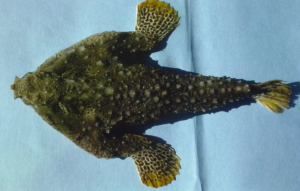
Sometimes I am just in awe of the variety and purely bizarre nature of the many fish in our seas. Today’s feature is not exactly anyone’s idea of a beauty, but its unique adaptations to life underwater make it a poster child for the many mysteries of life in the deep.
After a friend sent a photo (featured at the top of this blog post) asking for help with identification, on first glance I thought I was looking at a stargazer fish. As the name suggests, stargazers have a permanent upward look, as their eyes are positioned near the top of their heads and angled above. A stargazer is a type of anglerfish that sits on the seafloor bottom, using a lure attached to its body to attract prey swimming above, hence the upwards gaze. However, on closer observation and discussion with a fellow fish aficionado, it was clear this curious find was a batfish, most likely a “polka-dot” batfish (Ogcocephalus cubifrons).

In my copy of “Fishes of the Gulf of Mexico,” the batfish (also a type of anglerfish) is described as both “ugly” and “grotesque.” While certainly an odd-looking species, I find it more fascinating than off-putting. Like the stargazer’s dangling bait that floats up, the batfish has a protrusion near its mouth—although it hangs down to attract prey below. This lure is called an “esca” (Latin for “bait”) and contains a bioluminescent gland to attract potential prey. This prey includes slower-moving organisms like worms, mollusks, and small crabs.

Batfish are common bottom-dwelling species near the coastal shelf (up to 70 m deep) and are often bycatch in shrimp nets due to the bottom-dragging nature of the trawler boats. Baitfish are closely related to frogfish, although frogfish tend to be rounder and have upturned escas. Batfish bodies are flattened in shape—like they were stepped on—and get their common name from their broad pectoral fins. The fins spread outward from their bodies like bat wings. They have wide, boxy heads, terminal mouths, and large eyes. Polka-dot batfish bodies are covered in wartlike tubercles, which may function as skin protection in the absence of scales.

Their pectoral fins are fleshy and adapted for use not only while swimming but to crawl along the seafloor like legs. The back half of the batfish body tapers nearly to a point, ending with a smooth caudal fin like the body of an eel. From above, the batfish is shaped like an arrow. Any observant fisherman or student of fish physiology will know this body shape is not one of a fast swimmer, but a slow and camouflaged scavenger. Most of the batfish featured in this article were photographed all around Florida, but the species can be found along the Atlantic coast from North Carolina to Florida, and all along the Gulf states to Mexico.
 3
3
